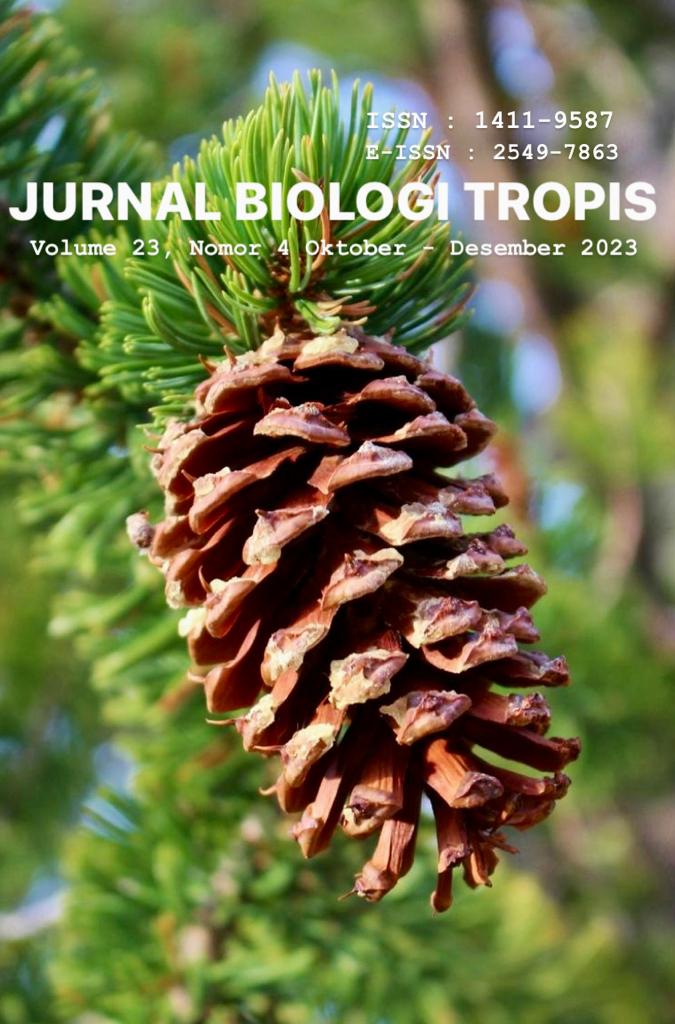The Potential of Saponin in Sea Cucumbers to Prevent Hyperlipidemia
Authors
Talitha Syahla , Diki Wahyudi , Sima Smith , Yumna Iftinan Khalda , Zulfa Hasyimiyyah Ihtisyam , Dini SuryaniDOI:
10.29303/jbt.v23i4.5740Published:
2023-10-16Issue:
Vol. 23 No. 4 (2023): October - DecemberKeywords:
Hyperlipidemia, lipid, saponin, sea cucumbers, traditional medicine.Articles
Downloads
How to Cite
Downloads
Metrics
Abstract
Hyperlipidemia is the main risk factor for atherosclerosis which can cause death. The occurrence of hyperlipidemia is relatively high with a percentage of 45% globally and 35% in Indonesia. The purpose of this article is to determine the potential of saponins in sea cucumbers as the ingredients used to prevent hyperlipidemia. The method used in this article is a literature study by collecting relevant and focused articles. The literature used were the National Center for Biotechnology Information (NCBI), the Multidisciplinary Digital Publishing Institute (MDPI), and Google Scholar. The results of the literature review carried out are that the saponins found in sea cucumbers are the main component as a lipid reducer compared to other compounds found in sea cucumbers. In conclusion, saponins in sea cucumbers influence lipid metabolism which ultimately prevents hyperlipidemia through various mechanisms.
References
Bahrami, Y., Zhang, W. and Franco, C. M. M. (2018) ‘Distribution of saponins in the sea cucumber holothuria lessoni; The body wall versus the viscera, and their biological activities’, Marine Drugs, 16(11). doi: 10.3390/md16110423.
Fagbohun, O. F., Joseph, J. S., Oriyomi, O. V., & Rupasinghe, H. V. (2023). Saponins of North Atlantic Sea Cucumber: Chemistry, Health Benefits, and Future Prospectives. Marine Drugs, 21(5), 262. DOI: 10.3390/md21050262.
Goobie, G. (2013) Primary Hypertriglyceridemia : Patho Clinical Findings, Calgary Guide. Available at: https://calgaryguide.ucalgary.ca/primary-hypertriglyceridemia-pathogenesis-and-clinical-findings/ (Accessed: 7 June 2023).
Guo, L., Gao, Z., Zhang, L., Guo, F., Chen, Y., Li, Y., & Huang, C. (2016). Saponin-enriched sea cucumber extracts exhibit an antiobesity effect through inhibition of pancreatic lipase activity and upregulation of LXR-β signaling. Pharmaceutical Biology, 54(8), 1312-1325. DOI: 10.3109/13880209.2015.1075047.
Guo, Y. et al. (2018) ‘Synergistic effect of eicosapentaenoic acid-enriched phospholipids and sea cucumber saponin on orotic acid-induced non-alcoholic fatty liver disease in rats’, Royal Society Open Science, 5(7). doi: 10.1098/rsos.172182.
Han, X. Q., Zhang, L. Y., Ding, L., Shi, H. H., Xue, C. H., Zhang, T. T., & Wang, Y. M. (2019). Synergistic effect of sea cucumber saponins and EPA-enriched phospholipids on insulin resistance in high-fat diet-induced obese mice. Food & Function, 10(7), 3955-3964. DOI: 10.3390/md18050274.
Hu, X. Q., Xu, J., Xue, Y., Li, Z. J., Wang, J. F., Wang, J. H., ... & Wang, Y. M. (2012). Effects of bioactive components of sea cucumber on the serum, liver lipid profile and lipid absorption. Bioscience, biotechnology, and biochemistry, 76(12), 2214-2218. DOI: 10.1271/bbb.120495.
Lin, P., Shen, N., Yin, F., & Guo, S. D. (2022). Sea cucumber-derived compounds for treatment of dyslipidemia: A review’, Frontiers in Pharmacology, 13(September), pp. 1–17. doi: 10.3389/fphar.2022.1000315.
Meng, J., Hu, X., Zhang, T., Dong, P., Li, Z., Xue, C., ... & Wang, Y. (2018). Saponin from sea cucumber exhibited more significant effects than ginsenoside on ameliorating high fat diet-induced obesity in C57BL/6 mice. MedChemComm, 9(4), 725-734. doi: doi.org/10.1039/C7MD00653E.
Moll, J. (2022) ‘What is secondary (acquired) hyperlipidemia?’, Verywell Health, September, pp. 1–19. URL: https://www.surveymonkey.com/mp/what-is-secondary-research/.
Naser, I. H., Alkareem, Z. A. and Mosa, A. U. (2021) ‘Hyperlipidemia : pathophysiology , causes , complications , and treatment . A review’, Kerbala Journal of Pharmacy and Pharmaceutical Science, 1(7).
Parhofer, K. G. (2016) ‘The Treatment of Disorders of Lipid Metabolism’, Deutsches Arzteblatt International, 113(15), pp. 261–268. DOI: 10.3238/arztebl.2016.0261.
Puspitasari, Y. E., Tuenter, E., Foubert, K., Herawati, H., Hariati, A. M., Aulanni’am, A. A., ... & Hermans, N. (2023) ‘Saponin and Fatty Acid Profiling of the Sea Cucumber Holothuria atra, α-Glucosidase Inhibitory Activity and the Identification of a Novel Triterpene Glycoside’, Nutrients, 15(4). DOI: 10.3390/nu15041033.
Santangelo, G., Moscardelli, S., Simeoli, P. S., Guazzi, M., & Faggiano, P. (2022) ‘Management of Dyslipidemia in Secondary Prevention of Cardiovascular Disease: The Gap between Theory and Practice’, Journal of Clinical Medicine, 11(15), pp. 7–11. DOI: 10.3390/jcm11154608.
Stewart, J., McCallin, T., Martinez, J., Chacko, S., & Yusuf, S. (2020). Hyperlipidemia. Pediatrics in review, 41(8), 393-402. DOI: 10.1542/pir.2019-0053.
Su, L., Mittal, R., Ramgobin, D., Jain, R., & Jain, R. (2021). (2021) ‘Current Management Guidelines on Hyperlipidemia: The Silent Killer’, Journal of Lipids, 2021, pp. 1–5. DOI: 10.1155/2021/9883352.
Wen, M., Fu, X., Han, X., Hu, X., Dong, P., Xu, J., ... & Wang, Y. (2016). Sea cucumber saponin echinoside A (EA) stimulates hepatic fatty acid β-oxidation and suppresses fatty acid biosynthesis coupling in a diurnal pattern. Journal of nutritional science and vitaminology, 62(3), 170-177. DOI: 10.3177/jnsv.62.170.
WHO (2022) Raised cholesterol, Word Health Organization. URL: https://www.who.int/data/gho/indicator-metadata-registry/imr-details/3236.
Yuan, Y., Liu, Q., Zhao, F., Cao, J., Shen, X., & Li, C. (2019). Holothuria leucospilota polysaccharides ameliorate hyperlipidemia in high-fat diet-induced rats via short-chain fatty acids production and lipid metabolism regulation. International Journal of Molecular Sciences, 20(19), 4738. DOI: 10.3390/ijms20194738.
Z Zhao, Y. C., Xue, C. H., Zhang, T. T., & Wang, Y. M. (2018). Saponins from sea cucumber and their biological activities. Journal of Agricultural and Food Chemistry, 66(28), 7222-7237. DOI: 10.1021/acs.jafc.8b01770.
Zhou, P., Yang, X., Yang, Z., Huang, W., Kou, J., & Li, F. (2019). Akebia saponin D regulates the metabolome and intestinal microbiota in high fat diet-induced hyperlipidemic rats. Molecules, 24(7), 1268. DOI: 10.3390/molecules24071268.
License
Copyright (c) 2023 Talitha Syahla, Diki Wahyudi, Sima Smith, Yumna Iftinan Khalda, Zulfa Hasyimiyyah Ihtisyam, Dini Suryani

This work is licensed under a Creative Commons Attribution 4.0 International License.

Jurnal Biologi Tropis is licensed under a Creative Commons Attribution 4.0 International License.
The copyright of the received article shall be assigned to the author as the owner of the paper. The intended copyright includes the right to publish the article in various forms (including reprints). The journal maintains the publishing rights to the published articles.
Authors are permitted to disseminate published articles by sharing the link/DOI of the article at the journal. Authors are allowed to use their articles for any legal purposes deemed necessary without written permission from the journal with an acknowledgment of initial publication to this journal.


























